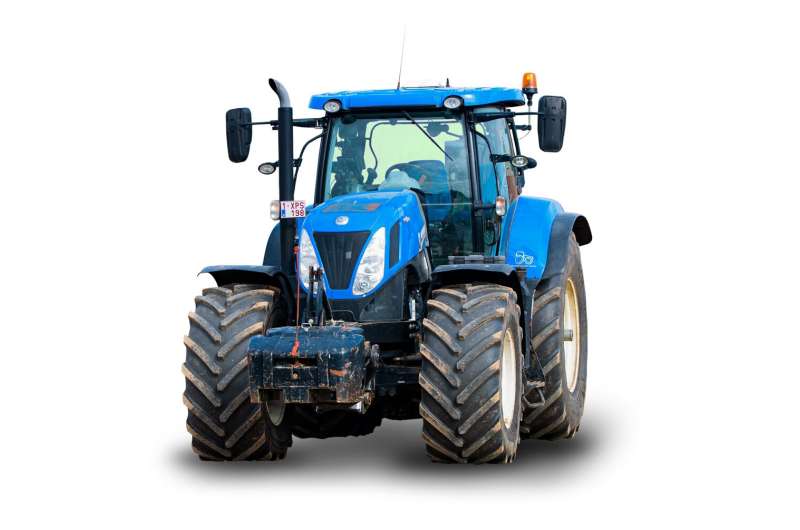This article has been reviewed according to Science X's editorial process and policies. Editors have highlighted the following attributes while ensuring the content's credibility:
fact-checked
trusted source
proofread
Automated agricultural machinery requires new approaches to ensuring safety, says study

From self-driving tractors to weeding robots and AI-powered data collection, automated machinery is revolutionizing agricultural production. While these technological advancements can greatly improve productivity, they also raise new questions about safety measures and regulations. To address these issues, a recent study from the University of Illinois reviewed current academic literature on the safety of automated agricultural machines. Based on a review of more than 60 papers, the researchers identified three main topics: environmental perception, risk assessment and mitigation, and human factors and ergonomics.
"The majority of the research focuses on the first category, environmental perception. These studies primarily deal with how machines sense obstacles in the environment and respond to them. There is limited work on risk assessment or ergonomics," said Salah Issa, Illinois Extension specialist and assistant professor in the Department of Agricultural and Biological Engineering (ABE), part of the College of Agricultural, Consumer and Environmental Sciences and The Grainger College of Engineering at the U of I. Issa is corresponding author on the paper.
Automated machines detect objects through perception sensors, which are then interpreted through machine learning algorithms to direct the equipment to stop, slow down, or change direction. There are three main types of obstacles that machines must be able to handle: positive, negative, and moving. Positive obstacles are objects that appear above ground, such as rocks, trees, and buildings. Negative obstacles are those that are lower than ground level, such as ditches and holes. Moving or dynamic obstacles are those that appear suddenly, such as a human being, an animal, or other moving machinery. These obstacles can vary widely, depending on type of crop, features of the area, and weather conditions.
Issa and co-author Guy Roger Aby, doctoral student in ABE, found the research papers explored a wide variety of different receptor and sensor types, including 3D laser scanners, ultrasonic sensors, remote sensing, stereo vision, thermal cameras, high-resolution cameras, and more. Each type has advantages and limitations, and the most effective approaches include a combination of different methods.
"The trend in literature is towards utilizing multiple types of sensors, as opposed to just a single sensor. This is also the direction most companies are taking. It makes perfect sense for agricultural machines, given the very dynamic environments they operate in," Issa noted.
"However, there are still many questions that need to be addressed. For example, sensors must be sensitive enough to stop immediately if a human or other object appears. But if the machine stops and the farmer is not present, would they need to go back to check on the sensor and reset the machine? This is particularly challenging when it comes to quickly moving obstacles, like a passing squirrel or bird."
Automatic agricultural vehicles face some of the same challenges as self-driving cars, but there are also notable differences. For instance, agriculture presents a more complex environment than city driving, where roads are structured and marked. However, erratic human behavior in other drivers is a concern on city roads, but is less of a factor in agricultural fields, Issa notes.
Only a few research papers addressed the second topic, risk assessment techniques and strategies. Issa says this is not surprising because most systems used in engineering for risk evaluation rely on historical data. That does not yet exist for autonomous systems in agriculture; there is little publicly available data about how they work and what the inherent risks are.
"We believe that existing safety standards are not well-suited for autonomous systems. But there's a significant effort underway to revise the current standards, so in a few years there will be new and revised standards," he said. Safety regulations addressing injuries and fatalities fall under the federal Occupational Safety and Health Administration (OSHA) but some states, including California and Indiana, also have their own regulations.
The researchers identified a limited number of papers on the third topic, human factors and ergonomics.
"This is a particularly challenging issue in agriculture. In most manufacturing industries, human-robot interaction can be minimized. But some agricultural robots, such as harvesters and pickers, are designed to work in the same space as humans. The few papers on this topic explored human-robot interactions from an ergonomic perspective, focusing on how to improve machine design to ensure safety," Issa said.
While autonomic robots are an emerging technology, some machines are already commercially available. For example, one company manufactures automatic sprayers for orchards, and self-driving tractors are being tested and implemented in select areas. Automated agricultural machines will undoubtedly become indispensable parts of modern farming in the next few decades, and robust safety systems are crucial for their widespread adoption, Issa and Aby concluded.
The research is published in the journal Safety.
More information: Guy R. Aby et al, Safety of Automated Agricultural Machineries: A Systematic Literature Review, Safety (2023). DOI: 10.3390/safety9010013
Provided by University of Illinois at Urbana-Champaign





















